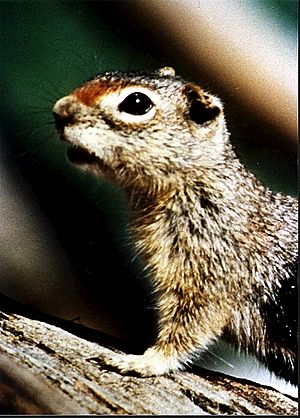Northern Idaho ground squirrel facts for kids
Quick facts for kids Northern Idaho ground squirrel |
|
|---|---|
 |
|
| Conservation status | |
| Scientific classification | |
| Genus: |
Urocitellus
|
| Species: |
brunneus
|
The Northern Idaho Ground Squirrel (Urocitellus brunneus) is a special type of ground squirrel found in Idaho. It belongs to the largest group of ground squirrels. This squirrel and the Southern Idaho Ground Squirrel were once thought to be the same species. They were both called the Idaho Ground Squirrel. Now, scientists know they are different.
Contents
What Does It Look Like?
Northern Idaho Ground Squirrels show something called sexual dimorphism. This means males and females look a bit different. Males are usually bigger than females.
These squirrels weigh between 120 and 290 grams. That's about as much as a small can of soda to a large can. They are usually around 233 millimeters long. This is about the length of a standard ruler. Their length can range from 209 mm to 258 mm.
Where Do They Live?
The Northern Idaho Ground Squirrel lives in specific parts of Idaho. You can find them in Valley and Adams Counties. They live in high places, from about 1,150 to 2,290 meters above sea level. That's like living on a tall mountain!
They live in about 50 small, separate groups. Each group is like its own little neighborhood of squirrels. These groups are often found in open meadows.
How Do They Behave?
These squirrels are champion sleepers! They spend about eight months of the year hibernating. Hibernation is a deep sleep that helps animals survive winter. During this time, their body temperature drops. Their heart rate and breathing slow down a lot. They wake up when the weather gets warmer.
Conservation Status
The Northern Idaho Ground Squirrel is currently listed as Threatened. This is under the U.S. Endangered Species Act. Being "Threatened" means they are likely to become endangered soon. This is a serious warning sign.
Why Are They Threatened?
Several things have made it hard for these squirrels to survive. In the past, some people tried to get rid of them. They used methods like poisoning and shooting. Also, changes in their habitat have caused problems.
One big issue is fire suppression. This means stopping natural wildfires. Wildfires used to keep meadows open. They would burn away young trees. Without these fires, young trees grow into the meadows. This makes the squirrels' homes smaller. They need open meadows to find food and stay safe.
What Is Being Done to Help?
The Idaho Department of Fish and Game keeps track of these squirrels. Their latest count suggests there are about 2,000 individuals left. This number is quite low.
Good news is that people are working to help them. Projects on the Payette National Forest are making a difference. Timber thinning involves carefully removing some trees. Prescribed fire means setting small, controlled fires. Both of these actions help to restore the open meadows. These efforts have helped some squirrel groups grow larger.


